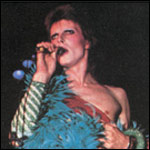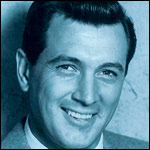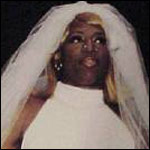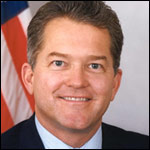1970: Bette Midler, camp out
In 1970, Bette Midler, mixing an outrageous blend of camp, sex talk, and Andrews Sisters tunes began performing at Manhattan’s Continental Baths. Within six months, she was one of Johnny Carson’s favorite guests, and in early 1973, her LP The Divine Miss M went gold. The rest has been wind beneath her wings. |  |
1972: David Bowie, alien sex
If the Rolling Stones shocked middle-class sensibilities with their rough, thrusting cock-rock swagger, it was Ziggy Stardust — a/k/a David Bowie — in 1972 who single-handedly invented glam rock, making androgyny, glitter, face paint, and ambisexual posturing the newest threat to red-blooded American youth, spawning artists such as KISS and Boy George. |  |
1977: The Village People, muscle shirts
In 1977, producer Jacques Morali manufactured disco sensation the Village People, who satirized butch gay-male stereotypes. What began as an insider parody sold more than 85 million albums and “YMCA” — a testimonial to anonymous gay-boy sex — is now a staple of summer-camp sing-alongs. | .jpg) |
1984: Madonna, art of the shallow
Her impersonations of Marilyn Monroe in her 1984 “Material Girl” video and appropriation of black-gay voguing in the 1990 hit “Vogue” made Madonna a premiere conduit of gay culture to the young masses. Aside from instructing teenage girls to wear devotional jewelry, she also was vehement in her endorsement of gay rights. | .jpg) |
1985: Rock Hudson, a crack in the mirror
Rock Hudson, the 1950s’ most vital, masculine, heterosexual heartthrob, died of AIDS-related infections in 1985, making Hudson’s long-rumored homosexuality all too visible. The culture shock was a result not only of his death, but of the new understanding that life beneath the tinsel of Hollywood was queerer than moviegoers had previously suspected. |  |
1992: Calvin Klein briefs, mmm . . .
Men’s bodies have always been sexualized in gay-male culture — Physique Pictorial of the 1950s became the template for male bods everywhere. But in 1992, photographer Herb Ritts upped the ante — and the booty — with his Calvin Klein ads, which brought a gay-porn sensibility to Vanity Fair. |  |
1997: Ellen, soft butch next door
In 1997, Ellen Degeneres — the most famous soft-butch in America, after Hillary Clinton — “came out” on her TV sit-com. The show was cancelled a year later, but Ellen made Will and Grace, Queer Eye for the Straight Guy, Queer as Folk, and The L World possible. |  |
1998: Dennis rodman, boa bad
Dennis Rodman’s 1998 autobiography Bad as I Wanna Be was as revealing as his flagrant display of body art. Rodman’s fondness of tattoos, piercings, flamboyantly colored cranial plumage, and wedding dresses was a triumph of mix-messaged drag/punk/biker gay sensibility — the precursor to the milder metrosexual. |  |
1998: Still more Sex and the City
It’s no surprise that critics thought Sex and the City (1998–2004) was the ultimate integration of gay-male sensibility into TV: it was written by gay men, and it’s edgy sexual dialogue and plots were gayer than Will and Grace. Is this what heterosexual women really sounded like in private? Only their screenwriters know for sure. Het-sexual freedom, once again, turned out to be a copy of queer life and love. |  |
2006: Mark Foley, closeted conservative
In September 2006, Florida Republican Congressman Mark Foley resigned amid allegations of improper behavior toward male pages; heterosexuals breathed a sigh of relief that it wasn’t — yet again — one of them. But Foley’s indiscretions evinced not only another crack in the facade of Republican respectability, but a true sign of the old gay-lib adage: we are everywhere. |  |